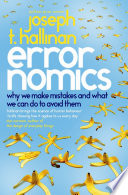

Human error is an inherent part of our cognitive processes. In 'Errornomics', the author delves into the psychology behind why we make mistakes, emphasizing that errors are not just random occurrences but predictable patterns influenced by cognitive biases and environmental factors. By understanding the mechanisms of human error, we can better anticipate potential mistakes in various contexts, from personal decision-making to organizational processes. The book outlines several types of errors, including slips, lapses, and mistakes, each rooted in different cognitive processes. For instance, slips often occur during routine tasks when attention wanes, while lapses are memory-related failures. Mistakes, on the other hand, arise from flawed reasoning or judgment. This categorization helps readers recognize that not all errors are created equal and that different strategies may be needed to mitigate them.
Continue readingThe environment plays a critical role in shaping the likelihood of errors. 'Errornomics' emphasizes that our surroundings can either facilitate or hinder our performance. Factors such as cluttered workspaces, poor lighting, and noisy environments can lead to increased mistakes. The author suggests that by optimizing our environments—be it in workplaces, educational settings, or even at home—we can significantly reduce the incidence of errors. For example, creating a more organized workspace can help minimize distractions, allowing individuals to focus better on their tasks. Additionally, the book discusses the importance of ergonomics and how designing tools and systems with human capabilities in mind can lead to fewer errors. This idea highlights the need for a systems approach to error reduction, where both individual behaviors and environmental factors are considered.
Continue readingCognitive biases are systematic patterns of deviation from norm or rationality in judgment, and they play a significant role in how we make decisions and errors. 'Errornomics' explores various cognitive biases, such as confirmation bias, overconfidence, and anchoring, which can lead individuals to make poor choices or overlook critical information. The author argues that by recognizing these biases, individuals and organizations can implement strategies to counteract their effects. For instance, fostering a culture of feedback and open communication can help mitigate overconfidence bias, as team members are encouraged to share diverse perspectives. Furthermore, the book discusses techniques such as checklists and decision matrices that can help individuals make more informed choices by counteracting cognitive biases.
Continue readingOne of the most valuable insights from 'Errornomics' is the importance of learning from mistakes. The author posits that errors should not be viewed solely as failures but as opportunities for growth and improvement. By analyzing errors and understanding their root causes, individuals and organizations can develop better practices and strategies to avoid similar mistakes in the future. The book provides a framework for error analysis, encouraging readers to adopt a mindset of curiosity rather than blame when mistakes occur. This approach fosters a culture of continuous improvement, where learning from errors becomes an integral part of personal and organizational development. The author also highlights the significance of psychological safety in fostering an environment where individuals feel comfortable discussing their mistakes without fear of retribution.
Continue readingIn 'Errornomics', the author advocates for systematic approaches to error reduction, emphasizing that ad-hoc solutions are often ineffective. The book outlines various methodologies and frameworks that organizations can adopt to systematically identify, analyze, and mitigate errors. Techniques such as root cause analysis, failure mode and effects analysis (FMEA), and the implementation of quality management systems are discussed in detail. These approaches provide a structured way to address errors at both individual and organizational levels. By adopting a systematic approach, organizations can create a culture of accountability and proactive error management, ultimately leading to improved performance and reduced risk.
Continue readingFeedback loops are crucial for error correction and improvement. 'Errornomics' emphasizes that timely and constructive feedback is essential for individuals and organizations to learn from their mistakes. The author discusses different types of feedback, including formal and informal, and how they can be effectively integrated into workflows. By establishing regular feedback mechanisms, organizations can create a dynamic environment where learning from errors is prioritized. The book also highlights the role of technology in facilitating feedback loops, such as using data analytics to track performance and identify areas for improvement. This idea underscores the need for a feedback-rich culture that encourages individuals to seek input and reflect on their performance continuously.
Continue readingFinally, 'Errornomics' stresses the importance of cultivating a culture of error awareness within organizations. This involves recognizing that errors are a natural part of any process and creating an environment where individuals feel empowered to report and discuss mistakes openly. The author argues that organizations that embrace error awareness are better positioned to learn from their experiences and foster innovation. Strategies for promoting a culture of error awareness include training programs, workshops, and leadership initiatives that emphasize the value of transparency and continuous learning. By normalizing discussions around errors, organizations can break down barriers to communication and create a more resilient workforce.
Continue reading